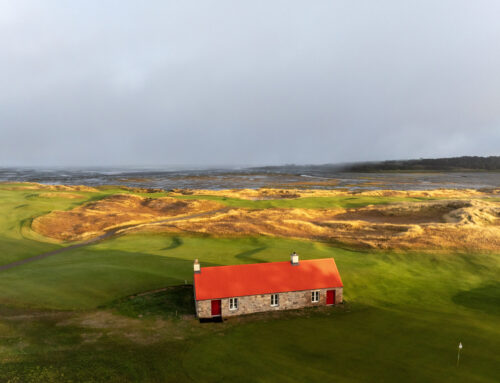The Top 100 Courses in the World: The Cookie Jar’s Ultimate Rank of Ranks
The Ranking of the ‘100 Greatest Courses in World’ serves as a lodestar for many golfers – the unattainable, complete ‘Pokedex’ for our millennial readers. And whilst only a lucky few could hope to tick-off all 100 (or even a majority of those listed), the ranking undoubtedly informs the planning of many golfing trips and adventures across the globe. But as you may have been wondering: which ranking (if any) should you choose?
We’ll begin this article with a few caveats. In no way is this an attempt to critique whether courses are under- or overrated, or whether a certain course deserves a higher or lower place in certain rankings. As a collective, we have played little more than a third of those listed below, and are simply unqualified to make such calls…
Instead, we want to shed some light on how the different global rankings rate each course, which courses garnered consensus, and which did not. The results are fascinating, and reveal the overall lack of consensus beyond a certain level, but we’ll let you judge for yourself.
The Rankings themselves…
There are really only three global rankings of courses which are widely published – for some reason unbeknownst to us, Golf World seem to exclude the USA from their most-recent list…
Top100GolfCourses.com, GOLF.com and Planet Golf are the 3 major rankings, and each employ a different system for rating courses. This is important context for understanding the different results…
- Top100GolfCourses.com – A Ranking for the People, by the People. Top 100 Golf Courses is largely a popular site, inviting contributions from members of the website to issue course ratings and reviews, however where rankings are concerned, these are conducted by their own expert panel, based on 3 key factors; Quality of design and test (40%), visual appearance and enjoyment (30%) and presentation (30%), and they lean on club professionals and club champions for further insight on the ground.
- GOLF.com – Ran Morrissett leads the esteemed ranking panel. As of November 2020, this panel comprises 97 of the most well-travelled and well-connected ‘aficionados’: including golf writers, renowned architects, and elite amateurs. These lucky folks are assigned, through a ballot system, to visit and ultimately rank the courses periodically.
- Planet Golf – Planet Golf is a ranking which is maintained by the Australian course designer and architect Darius Oliver, who has visited over 1,500 of the world’s finest golf courses. He is, of course, not subject to the same ‘checks and balances’ as panels of raters may be, and therefore ‘benevolent dictator rules’ apply…
The Method.
At its heart, the spreadsheet simply compiles the respective 1-100 ranking of each course across the three platforms: we simply add up the three ranks for each course to generate a combined total, with a lower score reflecting consensus regarding the excellence of the course. Of course, not all courses in the list are the same, and so courses which feature in two of the three lists are given a rank score of 110 for the third list, and courses which feature on only one of the three lists will be awarded 120 for their position in each of the remaining two. To arrive at this we even reached out to an actuary to find a sensible number to award (no stone left unturned at Cookie Jar HQ). Rationale:
‘’It seems to me that (based on a population of 140 courses) those listed twice are more likely to be ranked (say) 100-120 in the list they are missing from, whereas those only in one list will be spread out more from 100 – 140.
A pragmatic solution might therefore be to give those in two lists a notional position of 110th in the list they are missing from, and those missing from two a notional position of 120th in the two lists they are missing from’’
-Anonymous Actuary, Nov 2020
Nevertheless, we concede that this is far from a perfect solution: there’s simply no way of knowing whether GOLF.com would rank Silloth-on-Solway so highly in an expanded list, or whether Planet Golf would do the same for Walton Heath, to cite just two examples…
The table at the bottom will allow you to filter the rankings in different ways, and we’d encourage anyone to play with the spreadsheet and filter it however they choose. Our conclusions are below…
The Findings:
With 140 courses featuring in total, only 61 courses are listed by all three sites. 37 courses appear in two rankings, and 42 make only a solo showing. It is clear that consensus does not exist.
There is, however, unanimity regarding the two greatest courses on Earth: Cypress Point and Pine Valley occupy either first or second place in all three rankings. Pine Valley wins the hearts of Planet Golf and GOLF.com to swing the balance to PV for the top spot. There is also a high degree of consensus on places 3-7. NGLA, Shinnecock, County Down, Royal Melbourne (West) and the Old Course are separated by little more than a cigarette paper.
Consensus starts to fade as one approaches the halfway point. We looked at two things here:
-
- We took the average score across the ranks versus their ultimate rank. By looking at deviation from the average against their ultimate rank position, we can start to see how the degree of consensus wanes. After 45th place, occupied by Tom Doak’s 2006 construction in Colorado, Ballyneal, courses accumulate much higher average ranking points across all three ranks than their respective position.
- We can also see that we have to go all the way down to 53rd spot to find a course which does not feature in all three lists: Royal Aberdeen, one of the oldest courses in the world with a history dating back to 1780! The much younger Cape Kidnappers is also right behind it…
What can we learn from this? I guess, the use of ‘100’ being the absolute determinant of whether a course deserves to be among a privileged list of courses is probably the wrong number. If the purpose of rankings is to ascertain undeniably the best golf courses which any obsessive golfer (with a network of contacts and deep pockets to match) should aspire to play, then the rankings would be better served by only selecting the top 50. Individual bias seems to skew the data significantly beyond that…
We also did some further analysis to see which courses carried the greatest variation across their own scores. Naturally, the variation increases as you move further down the list. However, after controlling for this, some interesting names pop-up: Turnberry (Ailsa), Cape Wickham and Prestwick are three courses which occupy vastly different places in each of the rankings. Although the rationale isn’t clear, we might speculate as to whether the quirkiness of designs or political sentiment are contributing factors…
Indeed Cape Wickham, which enjoys positions of 55th and 60th in the Top100 and GOLF.com rankings respectively, sits at number 10 in Darius Oliver’s ranking for Planet Golf. It would be remiss of us, however, not to mention the fact that Oliver was responsible for finding the site and convincing wealthy investor Duncan Andrews to develop the course, which was designed by Mike DeVries and opened for play in 2015. This is not to criticise Darius’ excellent work as a writer and designer – but merely to highlight the subjective nature of rating courses. The lucky ones who get the chance to play Cape Wickham will have to draw their own conclusions as to whether it deserves a place in the World Top 10…
Of the courses which were only ranked in the Top 100 by one panel, the top-rated were Southern Hills (49th by GOLF.com), Royal Troon (51st by GOLF.com), the recently completed Sheep Ranch at Bandon (52nd by Planet Golf), and Pasatiempo (56th by Planet Golf). An eclectic mixture, to say the least…
Then there are the ‘sneaky ones’ that fly slightly under the radar, but appear in all three lists. For anyone who has spent time with Sam in the last 6 months, they will know that he is desperate to go to The Netherlands – ‘for golf’, he is quick to add! But in all seriousness, it’s easy to see why: Utrecht de Pan features in all three rankings, as does Royal Hague.
Then there are some courses which feature only occasionally, but are worthy of special mention. Bob Harrison’s ultra-exclusive Ardfin, which opened for play in 2010, features in only one ranking (Top100). Nevertheless, those that visit it from the GCA fraternity always seem to gush about its quality. To quote David Davis in our latest podcast, ‘I could easily make a case for this being in the top 5 courses in the world.’
Other honorary mentions include Eastward Ho! – a Herbert Fowler Golden Age classic situated in Massachusetts – the King’s Course at Gleneagles and the home of strategic golf course architecture, Woking. All of these have been highly ranked by Planet Golf but do not feature in the other two lists.
So… you, as the reader, should draw your own conclusions. If this analysis shows anything, it’s that the ranking of Top 100 courses is extremely subjective, particularly as one moves beyond the Top 50 mark.
The UK and Ireland are well-represented, though it is primarily our links courses which feature – probably due to the romantic notions of the game’s development on the sandy, links turf of the British Isles.
Moreover, despite the rhetoric about Golden Age course architecture, there is a strong showing of courses from every era, and almost all courses have benefited from the involvement of designers post-Second World War, or even more recently…
In the final analysis, a perfectly valid question might be: why do we bother having rankings at all? They clearly don’t capture the most important elements which make up an enjoyable round of golf, such as the company with whom you play. But they certainly help guide us golfers in planning our trips, and also allow golf courses to market themselves and celebrate their continual improvement. We guess that at the centre of it, we like to rely on a credible source of information as to a golf course’s quality. Much like spending money on a fine wine, people want to feel comfortable that their commitment (and sacrifices) to play somewhere can be justified. And, if nothing else, the rankings serve up lively debate in the clubhouse, which is never a bad thing…






